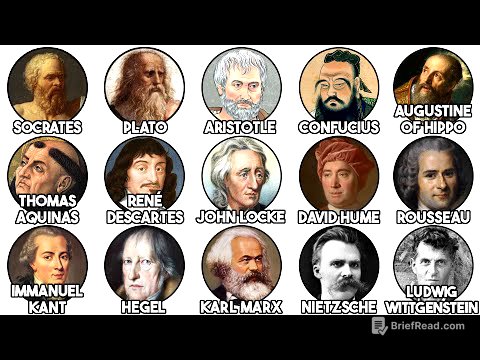TLDR;
This YouTube video by SPM IAS Academy provides an analysis of newspaper articles from July 10, 2025, covering a range of topics relevant to the UPSC civil services exam. Key topics include PM Modi's visit to Namibia and its implications for international relations and India's soft power, food wastage in India and initiatives to combat it, a comparison of atomic and optical clocks, and the issue of man-elephant conflict in Assam.
- PM Modi's visit to Namibia highlights India's growing soft power and collaborations in areas like UPI, biofuel, and disaster resilience.
- Food wastage in India is a significant issue, with 1/3 of food produced being wasted due to climatic conditions, poor storage, and social practices.
- Optical clocks are more precise than atomic clocks due to the use of strontium atoms, which fluctuate at a much higher frequency than the cesium atoms used in atomic clocks.
- Man-elephant conflict in Assam is increasing due to deforestation, habitat fragmentation, and disruption of elephant corridors, necessitating initiatives like Gaj Yatra and the Rehab Initiative.
Introduction [0:00]
The video introduces SPM IAS Academy's newspaper analysis for July 10, 2025. Viewers are instructed to download the PDF version of the analysis from the comment section. The session will cover several important topics from the day's news, relevant for the UPSC civil services examination.
Topics of the day [0:14]
The video outlines the topics to be covered in the newspaper analysis, which include PM Modi's visit to Namibia, food wastage in India, atomic clock vs optical clock, and man-elephant conflict.
PM Modi in Namibia [0:19]
PM Modi's visit to Namibia marks him as the first Indian Prime Minister to visit the country. The Namibian government honored him with its highest civilian award, adding to the 27 international honors he has received since 2014, reflecting India's growing soft power. During the visit, key decisions were made, including the launch of UPI in Namibia by the end of the year, facilitated by an agreement between NPCI and the Bank of Namibia. Additionally, India and Namibia will jointly open an Entrepreneurship Development Centre in Namibia. Namibia has also joined India's Global Biofuel Alliance and the Coalition for Disaster Resilient Infrastructure (CDRI).
Food wastage in India [7:07]
Food wastage in India is a significant issue, with approximately 1/3 of the food produced being wasted, according to the Food Safety and Standards Authority of India. This wastage is primarily due to hot and humid climatic conditions that promote bacterial activity, and poor storage facilities leading to post-harvest losses. To combat this, the Indian government has launched the Agriculture Infrastructure Fund Project, allocating ₹1 lakh crore to provide concessional loans to startups for developing agricultural infrastructure like cold storage in rural areas. Big fat weddings also contribute to food wastage due to excessive preparation. Annually, 68.7 million tons of food is wasted, costing $1.53 trillion in agricultural produce post-harvest. This wastage exacerbates hunger and malnutrition, causes economic losses (1% of GDP), and leads to urban flooding due to clogged drainage systems from unscientifically dumped waste. Initiatives like the Indian Food Sharing Alliance (IFSA) aim to collect and distribute excess food, and the PMG One Scheme focuses on converting food waste into usable fuel.
Atomic Clock vs Optical Clock [14:38]
The video explains the difference between quartz clocks, atomic clocks, and optical clocks. Quartz clocks, commonly found in homes, use a quartz crystal that vibrates 32,768 times per second when electricity is passed through it, marking one tick or one second. Atomic clocks, more precise, use cesium atoms. Electrons in cesium atoms jump between lower and higher energy levels upon absorbing microwaves and emit microwaves when returning to lower levels. The frequency of these jumps, which is 9,192,631,770 times per second, defines one second in atomic clocks. Optical clocks, even more precise than atomic clocks, use strontium atoms. Electrons in strontium atoms fluctuate 430 trillion times per second, measured using laser light. Atomic clocks use microwaves, while optical clocks use visible light. Scientists aim to redefine one second based on optical clocks by 2030 due to their higher precision.
Man-elephant conflict [25:06]
Man-elephant conflict in Assam has resulted in the loss of 1,468 human lives and 626 elephant deaths between 2000 and 2023. The conflict is primarily driven by deforestation, expansion of agriculture, human settlement encroachment on elephant habitats, habitat fragmentation, and disruption of elephant corridors. Elephants require these corridors to migrate between forested areas due to their large size and herd behavior. Key initiatives to mitigate this conflict include the Gaj Yatra Initiative, aimed at freeing elephant corridors from human interference, and proposed elevated corridors over National Highway No. 37 near Kaziranga to prevent elephant deaths during floods. Other measures include radio-collaring elephants for tracking, sensitizing local villagers, and the Rehab Initiative, which uses honey bees to deter elephants from raiding crops.
Answer to the previous day's questions [30:21]
The video provides answers to questions from the previous day, including one on the Belt and Road Initiative, where the second statement is identified as incorrect because India is not a part of the initiative. Another question related to the Green Climate Fund is discussed, with the correct answer being that both statements are accurate. Additionally, it's clarified that no district of Assam is in the top 10 metros.









